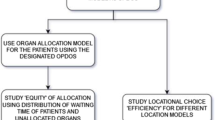Abstract
In this paper, we propose a location model for the optimal organization of transplant system. Instead of simulation approach, which is typical when facing many health care applications, our approach is distinctively based on a mathematical programming formulation of the relevant problem. In particular, we focus on the critical role of time in transplantation process as well as on a spatial distribution of transplant centers. The allocation of transplantable organs across regions with the objective of attaining regional equity in health care, is the aim of this paper. Our model differs from previous modeling approaches in that it considers the nationwide reorganization of the transplant system, identifying system barriers that may impair equity and efficiency. The demolition of these barriers may leads on a reduction of waiting lists and of wasted organs. We provide the basic structure and the properties of the model, and validate it on a real case study. The experimental validation of the model demonstrates the effectiveness and robustness of our proposal.
Similar content being viewed by others
References
Ubel PA, Loewenstein G (1996) Public perceptions of the importance of prognosis in allocating transplantable livers to children. Med Decis Mak 16(3):234–241
McMaster P (2000) Transplantation for alcoholic liver disease in an era of organ shortage. Lancet 355(202):424–425
Macinko JA, Starfield B (2002) Annotated bibliography on equity in health, 1980–2001. International Journal for Equity in Health 1:1
Zenios SA, Chertow GM, Wein LM (2000) Dynamic allocation of kidneys to candidates on the transplant waiting list. Oper Res 48(4):549–569
Kennedy I, Sells RA et al (1998) The case for ‘presumed consent’ in organ donation. Lancet 351:1650–1652
Wilbert B, Smits JMA, Deng MC, Hummel M, Schoendube F, Scheld H, Persijn G, Laufer G (2003) The heart allocation simulation model: a tool for comparison of transplantation allocation policies. Transplantation 6(10):1492–1497
Taranto SE, Harper AM, Edwards EB, Rosendale JD, McBride MA, Patrick Daily O, Murphy D, Poos B, Reust J, Schmeiser B (2000) Developing a national allocation model for cadaveric kidneys. Proceedings of the 2000 Winter Simulation Conference
Ozcan YA, Begun JW, McKinney M (1999) Benchmarking organ procurement organization: a national study. Health Serv Res 34(4):853–872
Kreke J, Schaefer J, Angus DC (2002) Incorporating biology into discrete event simulation models or organ allocation. Proceedings of the 2002 Winter Simulation Conference
Su X, Zenios SA (2005) Patient choice in kidney allocation: a sequential stochastic assignment model. Operation Research 53(3):443–455
Hornberger J, Ahn JH (1997) Deciding eligibility for transplantation when a donor kidney becomes available. Med Decis Mak 17(2):160–170
Brand DA (1998) Perfect timing, no remorse, and kidney. Transplantation Medical Decision Making 18:249–255
Kong N, Shechter S, Schaefer A, Stahl JE (2002 May 19–22) Organ transplantation regions: the need for optimization. IIE 2002 IERC, Orlando, Florida
Shechter SM, Bryce CL, Alagoz O, Kreke JE, Stahl JE, Schaefer AJ, Angus DC, Roberts MS (2005) A clinically based discrete-event simulation of end-stage liver disease and the organ allocation process. Med Decis Mak 25(2):199–209
Hakimi SL (1964) Optimum locations of switching centres and the absolute centres and medians of a graph. Oper Res 12:450–459
Balinski ML (1965) Integer programming: methods, uses and computation. Manage Sci 12:253–313
ReVelle CS, Swain RW (1970) Central facilities location. Geogr Anal 2:30–42
Vladimir Marianov, Daniel Serra (2004) New trends in public facility location modeling, economics Working Papers 755, Department of Economics and Business, Universitat Pompeu Fabra
Eken-Chaine M, Pliskin J (1992) Incorporating travel times in decisions about size and location of dialysis facilities. Med Decis Mak 12(1):44–51
Rahman Shams-ur, Smith David K (2000) Use of location–allocation models in health service development planning in developing nations. Eur J Oper Res 123:437–452
ReVelle CS, Marks D, Liebman JC (1970) An analysis of private and public sector location models. Manage Sci 16:692–707
Rushton G (1987) Selecting the objective function in location–allocation analyses. In: Ghosh and Rushton (eds) Spatial analysis and location–allocation models. Van Nostrand Reinhold, New York
Toregas C, ReVelle C Optimal location under time or distance constraints. Papers of regional science association 28:133–143
https://trapianti.sanita.it/statistiche/, http://www.ministerosalute.it/servizio/datisit.jsp
Optimization Modeling with Lingo, Lindo System Inc., 1415 North Dayton Street, Chicago
Rushton G, Krishnamurthi A (1983) Locational effciency of health care services in an Indian district, Paper delivered at the Meetings of The Association of American Geographers, Denver, Colorado
Rahman S, Smith DK (1996) The efficiency of inefficiency: the deployment of health facilities in rural Bangladesh. In: Alauddin M, Hasan S (eds) Economy, people, and the environment. Department of Economics, University of Queensland, Brisbane, Bangladesh, pp 197–209
Mehrez A, Sinuany-Stern Z, Arad-Geva T, Binyamin S (1996) On the implementation of quantitative facility location models: the case of a hospital in a rural region. J Oper Res Soc 47:612–625
Marsh MT, Schilling DA (1994) Equity measurement in facility location analysis: a review and framework. Eur J Oper Res 74(1):1–17
Daskin MS, Dean LK (2004) Location of health care facilities. In: Brandeau ML, Sainfort F, Pierskalla WP (eds) Operations research and health care. Kluwer’s International Series
Author information
Authors and Affiliations
Corresponding author
Rights and permissions
About this article
Cite this article
Bruni, M.E., Conforti, D., Sicilia, N. et al. A new organ transplantation location–allocation policy: a case study of Italy. Health Care Manage Sci 9, 125–142 (2006). https://doi.org/10.1007/s10729-006-7661-z
Published:
Issue Date:
DOI: https://doi.org/10.1007/s10729-006-7661-z




